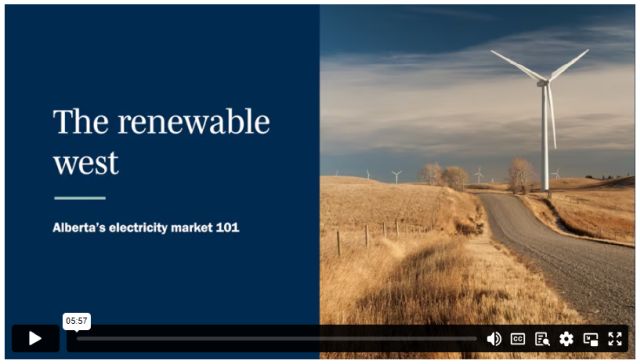Video transcript
Gino Bruni (00:05): A lot is happening in Alberta's electricity market. The Government of Alberta has been busy, from the moratorium on renewable projects that just ended, to the recent and ongoing changes to the electricity market.
Lou Cusano (00:16): That's right, Gino. There are many changes on the horizon. Additionally, there are other drivers influencing the changes in the province, such as the increased demand for electricity due to efforts to decarbonize, the adoption of EVs, and the introduction of high-powered drawing data centres for mining cryptocurrency. There is also rising concern regarding the adequacy of electricity supply and the reliability of intermittent sources of power, such as solar and wind.
The recent request to Albertans to reduce power in January, and the rolling brownouts that were experienced in early April have added to this concern. In this series of three videos, we'll be discussing where we are at and what is on the horizon for the Alberta power market. As a starting point, let's outline the basics of how the electricity system and market in Alberta works. Gino?
Gino Bruni (01:09): That's a great idea, Lou. The Alberta electricity system is comprised of four main parts the generation system made up of power plants that provide power to the grid, the transmission system of high-voltage wires that transmit high-voltage power across the province, the distribution system of low-voltage wires that run to your home or business, and finally, the retail component of the electricity system.
Under this final component, this provides consumers with the option to purchase electricity from a distribution utility offering a regulated rate option, or from an unregulated competitive retail on a fixed or variable contract. Competitive retailers purchase power from the energy market, arrange for distribution, and sell electricity and other services directly to end users. Now, in terms of the distribution and transmission systems, these are regulated by the Alberta Utilities Commission.
The Commission approves the facilities that are added to these systems and sets their rates. These rates are ultimately passed on to us as customers and permit distribution and transmission utilities to recover their costs, along with an opportunity to earn a fair rate of return.
Lou Cusano (02:18): What makes Alberta unique from other provinces is that generation is deregulated. This means private companies decide when generation should be built, what should be built and where it should be built in Alberta. Subject, of course, to any zones of restriction created by legislation or regulation, which we will return to in our next segment on the moratorium. The Alberta Utilities Commission still approves the construction and operation of generation facilities, but does not assess their need. Once in operation, generation earns revenue by being paid for each megawatt of energy it provides to the grid, as opposed to rates that may be regulated as they are for transmission and distribution.
This is why the Alberta market is called an "energy-only market", as opposed to other markets, where generators may also be compensated for being available to provide electricity to the grid. These are called "capacity markets". Alberta's energy only market is organized and monitored by the Alberta Electric System Operator, or the "AESO", who, among other things, sets the rules for the market known as the "AESO rules".
Gino, how is the price for electricity for generators set in Alberta?
Gino Bruni (03:32): Good question, Lou. Our starting point is the pool price. This is the price for electricity paid to generators for every hour of every day. The pool price is determined based on supply and demand. At the risk of oversimplifying, the process for how the pool price is set in a given hour is as follows.
First, generators offer a quantity of power at a certain price for a given hour in a day. The AESO then stacks all of these price quantity offers from generators into a merit order based on price from lowest to highest. Based on the demand for power, the AESO selects the number of offers needed to balance that demand. Moving up the merit order from lowest price to highest price. The price of the last and highest offer selected to balance supply and demand determines the pool price.
This single equilibrium price is the one and only clearing price that is paid to all generators for each megawatt of power that was selected in offers by the AESO. Regardless of a generator's initial offer, there is no locational pricing in Alberta. This means all generators at dispatch power receive that hourly price, no matter where the power is supplied to the grid.
Lou Cusano (04:45): Gino, let's take a moment to consider what this has meant for the renewables industry. The current energy-only market has incentivized many renewable projects to be built in the province in the past decade. The market combined with the open market for carbon offsets has led to several companies entering into power purchase arrangements as buyers to receive such offsets and other environmental attributes.
At the same time, through a contract for differences, these PPAs provide project owners a hedge on the price for power, which makes these projects attractive to financing. A good example is the 465-MW Travers Solar project, located in Southern Alberta, where Amazon entered into a PPA to receive the environmental attributes for 400 MW of the power plant. Gino, now that we have a handle on the basics of the electricity system and market in Alberta, let's turn to the recent announcements made by the Government of Alberta in our next segments, where we discuss the moratorium on renewables and announcement of a restructured energy market.
The content of this article is intended to provide a general guide to the subject matter. Specialist advice should be sought about your specific circumstances.



